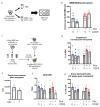Broad-Spectrum Antibiotics Deplete Bone Marrow Regulatory T Cells
- PMID: 33573218
- PMCID: PMC7911786
- DOI: 10.3390/cells10020277
Broad-Spectrum Antibiotics Deplete Bone Marrow Regulatory T Cells
Abstract
Bone marrow suppression, including neutropenia, is a major adverse effect of prolonged antibiotic use that impairs the clinical care and outcomes of patients with serious infections. The mechanisms underlying antibiotic-mediated bone marrow suppression remain poorly understood, with initial evidence indicating that depletion of the intestinal microbiota is an important factor. Based on our earlier studies of blood and bone marrow changes in a mouse model of prolonged antibiotic administration, we studied whether changes in megakaryocytes or regulatory T cells (Tregs), two cell types that are critical in the maintenance of hematopoietic stem cells, contribute to antibiotic-mediated bone marrow suppression. Despite increased platelet numbers, megakaryocytes were unchanged in the bone marrow of antibiotic-treated mice; however, Tregs were found to be significantly depleted. Exogenous addition of Tregs was insufficient to rescue the function of bone marrow from antibiotic-treated mice in both colony formation and transplantation assays. These findings indicate that the intestinal microbiota support normal Treg development to protect healthy hematopoiesis, but that the restoration of Tregs alone is insufficient to restore normal bone marrow function.
Keywords: T regulatory cells; antibiotics; bone marrow suppression; hematopoietic stem cell.
Conflict of interest statement
The authors declare no conflict of interest. The funders had no role in the design of the study; in the collection, analyses, or interpretation of data; in the writing of the manuscript, or in the decision to publish the results”.
Figures



References
-
- CDC Outpatient Antibiotic Prescriptions—United States, 2018. [(accessed on 7 January 2021)];2018 Available online: https://www.cdc.gov/antibiotic-use/community/programs-measurement/state-....
Publication types
MeSH terms
Substances
Grants and funding
LinkOut - more resources
Full Text Sources
Other Literature Sources
Medical

